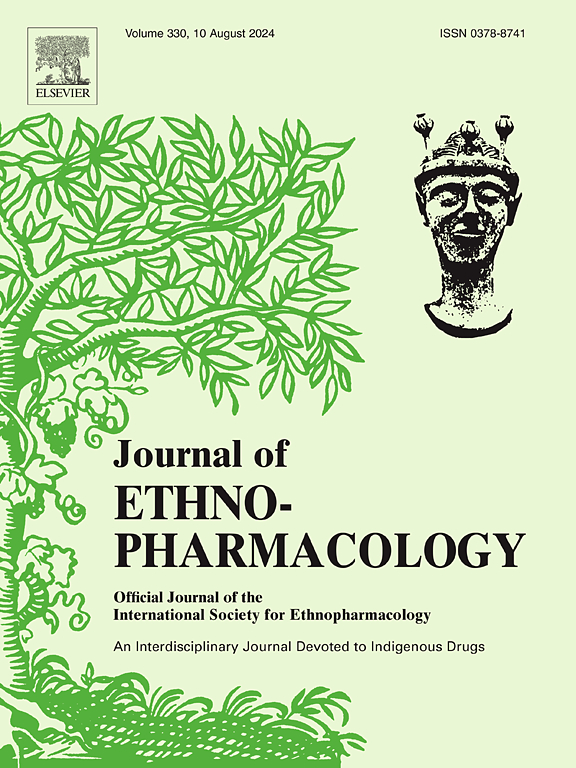丹参酮IIA通过SIRT1/Sestrin2/HO-1信号通路减轻脓毒症诱导的肝损伤
IF 4.8
2区 医学
Q1 CHEMISTRY, MEDICINAL
引用次数: 0
摘要
民族药理学相关性:丹参作为一种中药,被广泛用于治疗缺血性和炎症相关疾病已有2000多年的历史。丹参对肝脏有保护作用,但其作用机制尚不完全清楚。目的:验证丹参主要脂溶性成分丹参酮IIA (Tan IIA)对脓毒症/脂多糖诱导炎症所致肝损伤的影响,并进一步探讨其作用机制。材料和方法:小鼠在盲肠结扎穿刺(CLP)前2 h给予Tan IIA。采用苏木精-伊红染色及相关血清因子水平变化评价肝损害。免疫组化或western blotting检测沉默信息调节因子SIRT1 (SIRT1)、Sestrin2、HO-1及炎症因子的表达。采用LPS体外诱导炎症反应,western blotting检测Tan IIA相关信号通路的活性。使用SIRT1抑制剂EX-527和小干扰rna (sirna)来确定SIRT1和Sestrin2在Tan IIA功能中的关键作用。结果:我们发现Tan IIA能明显改善CLP小鼠肝脏的病理变化和功能,减轻肝损伤。此外,在体内和体外,与CLP组相比,Tan IIA治疗后SIRT1、Sestrin2和HO-1的表达均显著升高,并且Tan IIA治疗还抑制了促炎细胞因子的释放。然而,SIRT1或Sestrin2的抑制显著地取消了Tan IIA的保护作用。最重要的是,根据EX-527或siRNA处理后Sestrin2的表达变化,Sestrin2似乎在SIRT1的下游发挥作用。结论:Tan IIA通过SIRT1/Sestrin2 /HO-1通路抑制脓毒症/ lps诱导的炎症,从而对脓毒症诱导的肝损伤(SLI)具有保护作用。本研究提示Tan IIA具有治疗SLI的潜力,SIRT1/Sestrin2 /HO-1信号通路可能是治疗SLI的可行靶点。本文章由计算机程序翻译,如有差异,请以英文原文为准。

Tanshinone IIA, a component of Salvia miltiorrhiza Bunge, attenuated sepsis-induced liver injury via the SIRT1/Sestrin2/HO-1 signaling pathway
Ethnopharmacological relevance
As a traditional Chinese medicine, Salvia miltiorrhiza Bunge has been widely used to treat ischemic and inflammation-related diseases for more than 2000 years. S. miltiorrhiza Bunge has hepatoprotective effects, but the underlying mechanism is not fully understood.
Objective
To verify the effect of tanshinone IIA (Tan IIA), the main fat-soluble component of S. miltiorrhiza Bunge, on liver damage induced by sepsis/LPS-induced inflammation and further explore the underlying mechanisms.
Materials and methods
Mice were administered Tan IIA 2 h before cecal ligation and puncture (CLP). Liver damage was evaluated by hematoxylin-eosin staining and changes in related serum factor levels. The expression of silent information regulator sirtuin 1 (SIRT1), Sestrin2, HO-1 and inflammatory cytokines was examined by immunohistochemistry or western blotting. LPS was used to induce the inflammatory response in vitro, and the activity of the related signaling pathway in response to Tan IIA was detected by western blotting. The SIRT1 inhibitor EX-527 and small interfering RNAs (siRNAs) were employed to determine the key roles of SIRT1 and Sestrin2 in Tan IIA's function.
Results
We found that Tan IIA significantly improved the pathological changes and function of the liver, and alleviated liver damage in CLP mice. Additionally, SIRT1, Sestrin2, and HO-1 expression was significantly elevated after Tan IIA treatment compared with that in the CLP group both in vivo and in vitro, and Tan IIA treatment additionally suppressed pro-inflammatory cytokine release. However, inhibition of either SIRT1 or Sestrin2 remarkably abrogated the protective effects of Tan IIA. Most importantly, Sestrin2 appeared to function downstream of SIRT1 based on their expression changes after EX-527 or siRNA treatment.
Conclusion
Tan IIA inhibited sepsis/LPS-induced inflammation through the SIRT1/Sestrin2/HO-1 pathway, thereby protecting against sepsis-induced liver injury (SLI). This study suggests that Tan IIA has therapeutic potential against SLI and that the SIRT1/Sestrin2/HO-1 signaling pathway might be a viable target for SLI treatment.
求助全文
通过发布文献求助,成功后即可免费获取论文全文。
去求助
来源期刊

Journal of ethnopharmacology
医学-全科医学与补充医学
CiteScore
10.30
自引率
5.60%
发文量
967
审稿时长
77 days
期刊介绍:
The Journal of Ethnopharmacology is dedicated to the exchange of information and understandings about people''s use of plants, fungi, animals, microorganisms and minerals and their biological and pharmacological effects based on the principles established through international conventions. Early people confronted with illness and disease, discovered a wealth of useful therapeutic agents in the plant and animal kingdoms. The empirical knowledge of these medicinal substances and their toxic potential was passed on by oral tradition and sometimes recorded in herbals and other texts on materia medica. Many valuable drugs of today (e.g., atropine, ephedrine, tubocurarine, digoxin, reserpine) came into use through the study of indigenous remedies. Chemists continue to use plant-derived drugs (e.g., morphine, taxol, physostigmine, quinidine, emetine) as prototypes in their attempts to develop more effective and less toxic medicinals.
 求助内容:
求助内容: 应助结果提醒方式:
应助结果提醒方式:


